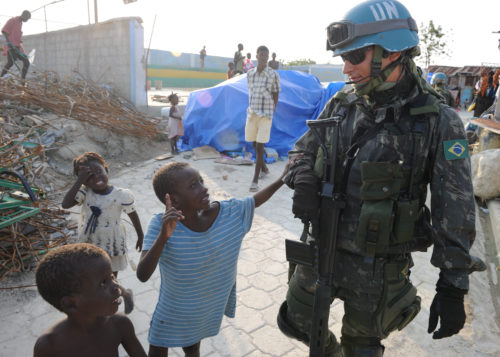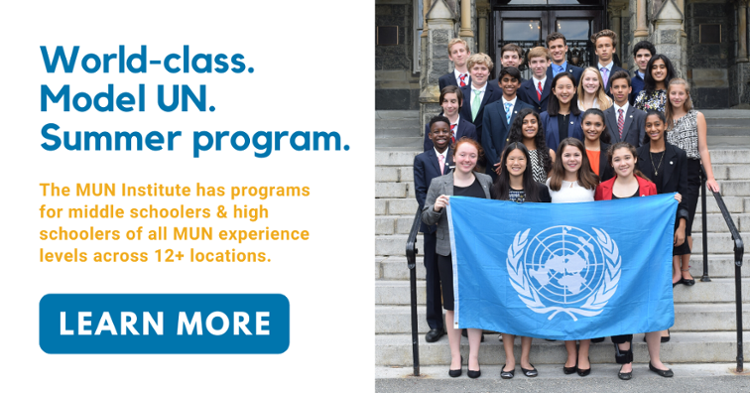
A Brazil-provided UN Peacekeeper in Haiti
The United Nations has no army, but it does have UN Peacekeepers. The goal of UN Peacekeepers is to create conditions for lasting peace. Peacekeeping is guided by three principles: consent of parties (countries must invite UN peacekeepers to enter; the UN cannot just send peacekeepers anywhere), impartiality, and non-use of force except in self-defense and defense of the mandate written in the resolution. Peacekeepers are sent upon UN Security Council recommendations, and often only when ceasefire has already been established as most countries do not want their soldiers to enter into active war zones.
The UN currently has 100,950 peacekeepers as of August 2016 (the latest data available). If the UN peacekeeping force was ranked against national militaries, it would be the 44th largest military in the world, or around the same size as the number of active military troops in Malaysia or Angola.
The 100,950 UN Peacekeepers are currently deployed on 20 UN peacekeeping missions around the world. The largest mission is the United Nations Organization Stabilization Mission in the Democratic Republic of the Congo, or MONUSCO, with 18,333 UN Peacekeepers deployed.
123 countries currently provide the military troops and police forces that make up the UN Peacekeeping force. Countries can also provide experts as part of a peacekeeping mission.
Here are the Top 25 countries providing UN Peacekeepers:
- Ethiopia (8,326)
- India (7,471)
- Pakistan (7,161)
- Bangladesh (6,772)
- Rwanda (6,146)
- Nepal (5,131)
- Senegal (3,617)
- Burkina Faso (3,036)
- Ghana (2,972)
- Egypt (2,889)
- Indonesia (2,867)
- China (2,639)
- Tanzania (2,341)
- Nigeria (2,170)
- Niger (1,871)
- Togo (1,661)
- Morocco (1,607)
- Chad (1,489)
- Uruguay (1,457)
- South Africa (1,427)
- Brazil (1,303)
- Kenya (1,229)
- Benin (1,174)
- Cameroon (1,137)
- Italy (1,114)
You can find the list of all 123 countries ranked here.
Ethiopia is the #1 provider with 8,326 peacekeepers, or about 6% of its 138,000 active military troops. Their peacekeepers primarily support UNAMID in Darfur, Sudan, and UNISFA between Sudan and South Sudan. Responsibility for peacekeeping has increasingly shifted toward regional leaders, and African countries are among the top providers of peacekeepers as many UN peacekeeping missions are located in Africa.
South Asian countries have traditionally been top providers for peacekeepers. India, Pakistan, and Bangladesh are all in the top five, and Nepal is sixth in terms of peacekeepers. Almost all of their peacekeepers are deployed on missions in Africa. This is partially because the UN pays a standardized reimbursement rate that is higher than the cost of that troop’s salary. For example, an entry-level soldier in India makes about 25,000 Indian rupees (approximately $366) per month, but the UN will reimburse the government of India the standard rate of $1,332 per soldier per month. That said, India also sees its high peacekeeping contribution as a reason for why it should have a seat on the UN Security Council.
China has historically been reluctant to intervene in other countries and traditionally did not provide peacekeepers. However, that has recently changed. China is now the 12th largest provider of peacekeepers. It is also a P5 Member of the Security Council (the UN organ that can send peacekeepers) and the second-largest contributor to the UN peacekeeping budget. In other words, China is now an active player from the beginning-to-end in peacekeeping operations: it votes on the resolutions to send peacekeepers, it deploys its own troops as peacekeepers, and it funds the peacekeeping missions.
Keep in mind that funding the UN peacekeeping missions is different than providing UN peacekeepers. UN peacekeeping missions are funded by assessments (similar to how the overall UN General Assembly budget is funded). That means every UN Member State is required to pay a percentage of the total UN peacekeeping budget roughly proportional to that country’s gross domestic product (GDP). Member States can voluntarily contribute more funding or equipment and supplies if they wish.
The approved budget for UN peacekeeping operations for the fiscal year of July 1, 2016 to June 30, 2017 is $7.87 billion, which is slightly smaller than its previous fiscal year’s budget. A military budget of $7.87 billion would rank the UN 26th if compared against other national military budgets, or smaller than Poland’s military budget of about $9 billion.
The Top 10 countries funding the UN peacekeeping budget are:
- United States (28.57%)
- China (10.29%)
- Japan (9.68%)
- Germany (6.39%)
- France (6.31%)
- United Kingdom (5.80%)
- Russian Federation (4.01%)
- Italy (3.75%)
- Canada (2.92%)
- Spain (2.44%)
You can find the full list of assessments for all 193 Member States in the latest General Assembly resolution here.
So the next time UN Peacekeepers are brought up, make sure the committee knows how the peacekeeping missions function, who provides the peacekeepers, and who funds the peacekeeping missions! This includes knowing your own country’s personnel and financial contributions to such missions, which would partially help inform your country’s policy toward such solutions.
More advanced tips and training can be found at the Model United Nations Institute!



